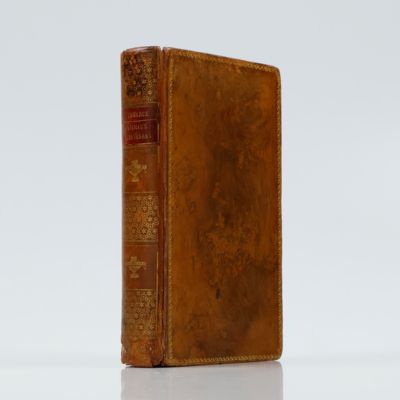Lamarck, J. B. [P. A. de Monet de]
Systême des animaux sans vertèbres, ou tableau général des classes, des ordres et des genres de ces animaux. Présentant leurs caractères essentiels et leurs distribution, d'après la considération de leurs rapports naturels et de leur organisation, et suivant l'arrangement établi dans les galeries du Muséum d'Hist. Naturelle, parmi leurs dépouilles conservées; précédé du discours d'ouverture du Cours de Zoologie, donné dans le Muséum National d'Histoire Naturelle, l'an 8 de la republique.
Paris, l'Auteur, Deterville, 1801. 8vo (19.2 x 12.0 cm). viii, 432 pp.; seven tables (six larger, folded). Contemporary full tree calf. Spine rich gilt in Empire style with vases and intricate patterns including stars, and red morocco label with gilt title. Boards with gilt-rolled borders. Marbled endpapers. Edges speckled red.
First edition (published by himself) of Lamarck's most important malacological contribution. In this work, the French zoologist and botanist Jean-Baptiste Pierre Antoine de Monet, Chevalier de Lamarck (1744-1829) effectively ended the reign of the original, artificial "lumping" Linnaean systematics, e.g., introducing many new animal classes and the term "invertebrates", together with numerous new genera - of shells and insects in particular. It forms a prelude to his Philosophie Zoologique, published in 1809. "Lamarck began as an essentialist who believed species were unchanging; however, after working on the molluscs of the Paris Basin, he grew convinced that transmutation or change in the nature of a species occurred over time. He set out to develop an explanation, and on 11 May 1800 (the 21st day of Floreal, Year VIII, in the revolutionary timescale used in France at the time), he presented a lecture at the Muséum National d'Histoire Naturelle in which he first outlined his newly developing ideas about evolution. In 1801, he published Système des Animaux sans Vertèbres [this work], a major work on the classification of invertebrates. In the work, he introduced definitions of natural groups among invertebrates. He categorized echinoderms, arachnids, crustaceans, and annelids, which he separated from the old taxon for worms known as Vermes. Lamarck was the first to separate arachnids from insects in classification, and he moved crustaceans into a separate class from insects" (Wikipedia). True first edition. Without the later p. 402bis. Spine foot frayed and lower joints starting; mostly faint damp-stain in the second half of the book; otherwise, an excellent copy of this rare work. Cat. BM(NH), p. 1048; Horn-Schenkling, 12685.




